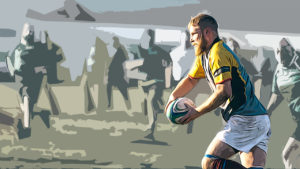Can I play rugby with shin splits?
- Patrick Dale
- Injuries, Injury Prevention
Rugby is a sport that involves a lot of running. Some of that is in the form of sprinting, but most of it is just regular running and jogging. Studies suggest that backs cover 7-7.5 km per game, while forwards run between 5-7 km, depending on their position, with loose forwards tending to cover the greatest distance.
Because of all this running, most ruggers include jogging and running in their training programs. Not only is it a sport-specific activity, but it’s also one of the best and most convenient cardiovascular training methods. It’s also useful for weight management too.
While running in rugby is unavoidable, it’s not without drawbacks. Ruggers are usually heavier than the average jogger and running places a lot of stress on your body.
Your feet hit the floor with force equal to about eight times your body weight when you run. That’s a lot of stress if you weight 140 lbs. But if you’re a 220 lbs. prop that could lead to injury.
One of the most common running-related injuries for ruggers is shin splits.
WHAT ARE SHIN SPLINTS?
Shin splints is the colloquial term to describe a medical condition called medial tibial stress syndrome, or MTSS for short. It is characterized by pain in the front of the lower leg between the knee and ankle – the shin.
MTSS is a cumulative condition that comes on gradually and is typically caused by repetitive impacts, such as running and jumping. The excessive force on the shin bone (tibia) and the muscles and tissues around this area swell and become inflamed, which produces pain. Shin splints cause radiating pain and also make the affected area painful to the touch.
The pain can be anything from mild to severe, depending on how advanced the condition has been allowed to become. A lot of ruggers ignore the early signs of shin splints, and, subsequently, it can become very painful indeed.
It’s important to note that shin splints are not the same as stress fractures, but the symptoms are very similar. However, the constant pounding that can cause shin splints can also lead to stress fractures, especially if ignored.
The symptoms of shin splints are:
- A dull ache in the front of the lower leg
- Pain that worsens during exercise
- Pain on either side of the shin bone
- Tibialis anterior muscle pain
- Swelling in the lower leg
- Numbness and weakness in the feet
Shin splints are so common that they are usually diagnosed from the symptoms they present. If you have pain in the front of your shin and haven’t recently been kicked in the lower leg, it’s probably shin splints. Medically, shin splints are usually diagnosed through palpation, but a cautious doctor may also prescribe x-rays to eliminate the possibility of stress fractures.
Who develops shin splints?
Not all rugby players will get get shin splints, despite some players putting a lot of time and effort into running. Factors that increase your risk of developing shin splints include:
- Bodyweight – the heavier you are, the greater the shin stress
- Anatomical abnormalities – such as flat-footedness
- Weak hip external rotators, leading to gait abnormalities
- Poor flexibility
- Poor running technique
- Running too far too soon
- Too much downhill running
- Too much running on uneven surfaces
- Too much running on hard surfaces, such as concrete
- Wearing shoes that have insufficient support or shock absorbency
- Wearing worn-out running shoes
Treatment of shin splints
The good news is that, while painful, shin splints are rarely serious, and a few weeks away from high-impact training should be all you need to get over this problem. Additional interventions that can help include:
- Keep your legs elevated – try raising the foot end of your bed slightly
- Use ice packs to reduce swelling
- Use over-the-counter anti-inflammatories, such as ibuprofen
- Wear elastic compression socks
- Massage your shins or use a foam roller
- Use anti-inflammatory gels on the affected area
In some instances, shin splints are treated surgically, although this is usually reserved for people who suffer this problem frequently, or if it lasts for more than a couple of months, despite resting. This sugary is called a fasciotomy and involves making small cuts in the fascia surrounding the affected muscles. This relieves the pressure around the tibialis anterior, which should alleviate the pain and prevent reoccurrence.
How to avoid shin splints
As with most chronic rugby injuries, prevention is always preferable to cure. If you feel the beginnings of pain in your shins, or have a history of shin splints and want to avoid getting it again, put the following tips into action:
- Buy running shoes made for your gait and running style. Make sure they are both supportive and shock absorbent. Replace your running shoes after every 500 miles, or when you notice they are losing their cushioning.
- Add after-market shock-absorbing insoles to further reduce impact stress.
- Have your gait analyzed by a podiatrist who may suggest orthotic insoles to correct any abnormalities.
- Include more low and non-impact training in your workouts, such as rowing.
- Run on mixed surfaces, and not just roads. Run on grass, wooded trails, sand, gravel, as well as tarmac.
- Increase running distance and frequency gradually. For distance, use the 10% rule – never increase the length of a run or the distance you run per week by more than 10% at a time. Most ruggers should not run more than 2-3 times per week.
- Stretch and strengthen your tibialis anterior.
- Warm-up your calves, ankles, and shins before you train.
- Lose weight – carrying extra weight puts more stress on your shins when you run. Do not run wearing a backpack or weighted vest.
- Include more low-impact exercises in your workouts.
- Do more uphill running and sprints, and less downhill – running uphill involves less impact.
- Decelerate gradually after sprints – putting on the brakes too hard or soon increases shin stress.
Training with shin splints
If you have shin splints and you want them to heal, you’ll need to lay off the impact for a while. Most cases of shin splints get better in 2-4 weeks. During this time, you should avoid running and jumping, and reduce the amount of walking you do too.
However, this doesn’t mean you can’t train. In fact, there are still lots of different types of workout you can do. Good alternatives to high impact running and jumping include:
- Cycling
- Rowing
- Stepper machines
- Swimming
- Metabolic Resistance Training
- Assault bike training
- Non-impact circuit training and Peripheral Heart Action training
- Cross country skiing
- Deep water running
- Deep water plyometrics
Can I play rugby with shin splints?
You can, but we don’t recommend it, especially if your shins are currently lit up and inflamed. Remember, you’ll probably run anywhere between 5-7 km during a game, and that’s a whole lot of potentially inflammatory impact.
If you have very mild or early-onset shin splints, you could conceivably play a game per week and then avoid all impact for the remaining six days, but this will only delay your recovery, even if you don’t make things worse.
Remember that rugby, like any recreational sport, should enhance your health, and not damage it. We play this game for fun and missing a couple of games is a small price to pay for letting an injury heal so you can come back ready to play at your best.
Wrapping up
While you don’t have to run to get fit for rugby, most players are drawn toward running and hit the road at least a few times per week. And, of course, running during a match is unavoidable – esp. if you want to keep your place on the team!
On the downside, running is hard on your joints and is especially tough on your shins. Most running shoes, running workouts, and running advice is aimed at super-skinny ectomorphic athletes who are at very low risk of getting shin splints.
In contrast, ruggers are usually beefy mesomorphs or endomorphs, and while that mass is crucial on the rugby field, it can be problematic if you do a lot of running.
Use the information in this article to prevent and treat shin splints. But, whatever you do, don’t try and train through this chronic injury. Ignored shin splints can become stress fractures, and they will take months to heal.


